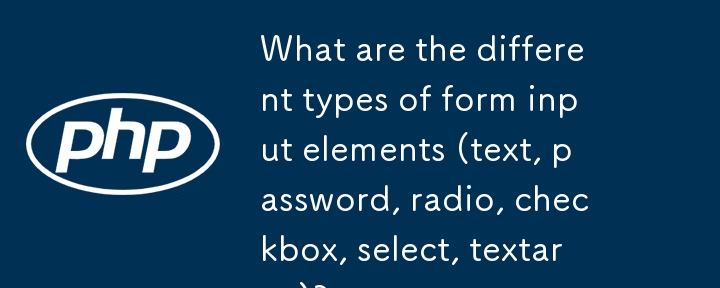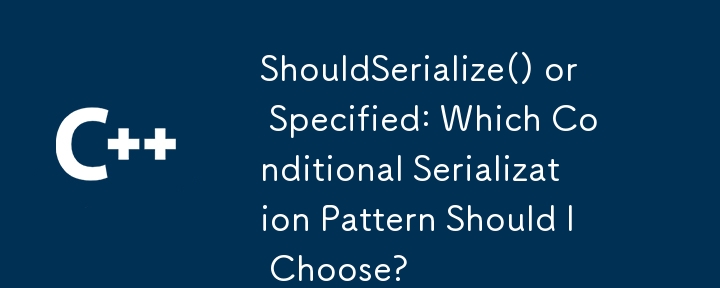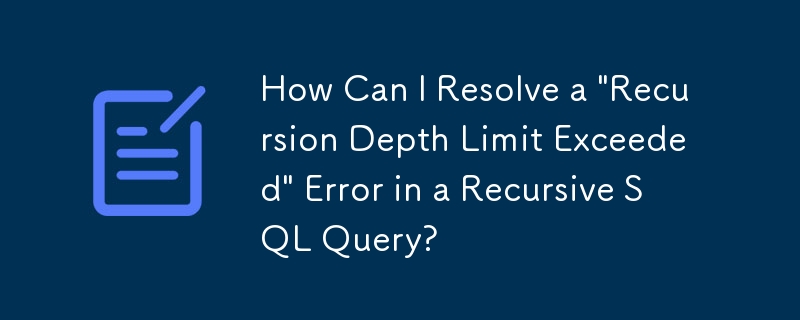Found a total of 10000 related content

How to make form input fields mandatory using html attributes?
Article Introduction:The most direct way to make the input box in the HTML form required is to use the required property. This property is a Boolean type, and no value is required. It can be used to verify it on the input, select or textarea tags, such as:; Common matching types include text, email, password, etc.; for checkbox, directly add required to force check; in the radio button group, just add required to the first option; the select drop-down box needs to set the default empty value option to trigger verification; different browsers may have different styles and contents of prompt information. If a unified prompt effect is required, you can customize it with JavaScript or third-party libraries for customization.
2025-07-07
comment 0
778

How do I use the placeholder attribute to provide a hint to the user about what to enter in the input field?
Article Introduction:The placeholder property is used to display prompt text when the input box is empty, but it cannot replace label or form verification. Correct usage includes: 1. It must be used with label to improve accessibility; 2. Do not use placeholder to replace the required prompts, and should be combined with the required attribute; 3. Avoid placing too much explanation information in placeholder; 4. Set appropriate example text according to different input types, such as text, email, password and other input boxes.
2025-06-28
comment 0
503

Which HTML tags are used to create a form?
Article Introduction:To create an HTML form, there are 5 main tags, namely,,,, and. 1. It is a form container, responsible for organizing and submitting data. Common properties include action, method and enctype; 2. Define multiple input types such as text, password, email, radio, checkbox and submit through type attributes; 3. Used to enter multiple text lines; 4. Used to create a drop-down selection menu in conjunction with creating a drop-down selection menu; 5. Used to submit or trigger interactive behavior, and combine it to improve accessibility and user experience. Master these tags and corresponding attributes to build a complete web form.
2025-07-01
comment 0
928

How does the required attribute work for form validation?
Article Introduction:The required property is used to set the form field to be required, and the user cannot submit it if it has not filled in. 1. Add required attributes to HTML, without JavaScript; 2. It is often used with input types such as text, email, number, checkbox, radio, etc.; 3. The default prompt information of the browser cannot be customized, and JavaScript must be matched when a unified prompt is required; 4. Situations that may not work include: the submission button has formnovalidate attribute, the input box is disabled, the label structure is incorrect, or browser compatibility issues.
2025-06-28
comment 0
201

How can CSS be used to style form elements consistently across different browsers?
Article Introduction:To keep a form element consistent in style across different browsers, you must first reset the default browser style. The steps include: 1. Use CSS to reset or normalize.css to clear the default style; 2. Clearly set border, padding, margin, font-family and appearance attributes; 3. Customize the appearance of the input box after removing the native style; 4. Use pseudo-elements and hide the original input box to implement custom check boxes; 5. Make limited style modifications to the select element or use JavaScript to build a custom drop-down menu. These methods can achieve cross-browser consistency, but some complex elements such as select may require additional tool assistance.
2025-06-12
comment 0
1008

Providing suggestions for form inputs with the HTML5 `` element.
Article Introduction:Using HTML5 elements can effectively improve the form input experience. 1. The basic usage is to bind the same through the list attribute, for example, setting the list value of the input box is the same as the datalist id; 2. It not only supports text input, but also applies to types such as numbers, colors, etc., but some types such as colors may not display a suggestion list in the browser; 3. You can dynamically fill options through JavaScript to load data from arrays or interfaces, and combine input events to achieve real-time search suggestions; 4. In terms of style, it mainly controls the appearance of the input box, the style of the drop-down list is limited, and you need to pay attention to the compatibility issues between the mobile and old browsers, and the server still needs to verify and fault tolerance.
2025-07-09
comment 0
221

How to validate a form with js?
Article Introduction:The key to form verification is to clarify the rules, reasonably bind events, and friendly prompt users. 1. Determine the fields to be verified, such as required items, format verification (email, phone number), and length limit (such as at least 8 digits of password); 2. Listen to the submit event through addEventListener and get the input value, and use e.preventDefault() to prevent the default submission; 3. Display error prompts. It is recommended to use elements to display specific information and clear the prompts when the input box gets focus; 4. You can combine HTML5 built-in verification attributes such as required, type="email", and minlength to improve compatibility, but it is still recommended to customize the prompts to maintain consistency.
2025-06-29
comment 0
366

What are the different types of form input elements (text, password, radio, checkbox, select, textarea)?
Article Introduction:When building a web form, you should select the appropriate input element according to the required data type. 1. Text input is used for short text such as name or email, and is used with placeholders, maximum character restrictions and labels; 2. Password field hides user input, requires pairing verification and prompts for requirements; 3. Radio buttons are used to select one of multiple options, and share name attributes; 4. Check boxes allow multiple selections, suitable for boolean values ??or function selection; 5. The drop-down menu saves space and is suitable for known option lists; 6. Multi-line text boxes are used for long content input, supporting line breaks. Rationally combining these elements can improve form functionality and user experience.
2025-06-26
comment 0
785

How to create a form in HTML?
Article Introduction:To create an HTML form, you need to master the basic tags and structure. The specific steps are as follows: 1. Use the tag to wrap the content and set the action and method attributes; 2. Add input fields such as text, password, radio, checkbox, email and submit; 3. Use and implement the information of the tags to improve the interactive experience and add the name attribute to each input item; 4. Use and implement the drop-down menu and multi-line text input; 5. Pay attention to the settings of required items, the various implementation methods of the submission button, and the customization of form styles. Master these key points to quickly build a complete HTML form.
2025-07-05
comment 0
169

Creating autocomplete dropdowns with the HTML5 datalist element.
Article Introduction:The key to creating an automatic completion drop-down box using HTML5's datalist element is to correctly associate and relate. 1. The basic structure is: to set the list attribute and match the id; 2. The supported input types include text, search, number, range, date, etc., but non-text types may have poor compatibility on the mobile side; 3. The options can be dynamically filled with JavaScript, but performance optimization needs to be paid attention to; 4. The mainstream browsers have good support, and old devices can consider polyfill or custom solutions instead.
2025-07-02
comment 0
151

What is the element and how does it work with an ?
Article Introduction:Is an element in HTML that provides predefined suggestions for fields, which is used in conjunction with list attributes with matching ids to display drop-down options when user input. The specific steps are as follows: 1. Define and set the id; 2. Use the list attribute to associate the id. For example, the input box will automatically filter and display the matching fruit name based on the user input. Notes include: Users can select suggestions or enter them by themselves, browser support is inconsistent, and JavaScript dynamic fill options are available. In addition, the default filtering method of the browser is simple, and it needs to be implemented manually if advanced filtering (such as fuzzy search). This function is suitable for scenarios that require speeding up data input but allow custom input, such as search bars, city names, labels, etc., but is not suitable for strict
2025-06-30
comment 0
734

What are the essential elements for building forms in html?
Article Introduction:To create a fully functional HTML form, it must include the following core elements and steps: 1. Use tags as form containers and set properties such as action, method, enctype; 2. Add input controls such as text boxes, password boxes, submission buttons, radio buttons, check boxes and drop-down selection boxes; 3. Set name attributes for each control so that the server can identify data; 4. Use tags to improve usability and enhance interaction efficiency; 5. Use placeholder, required, aria-label and other properties to optimize user experience; 6. Consider mobile adaptation, use appropriate inputtype and combine it with front-end verification mechanism; 7. Provide clear error prompt information, and ensure that
2025-07-04
comment 0
819


Dave The Diver: How To Catch Spider Crabs
Article Introduction:In Dave The Diver, there are some creatures that are not easy to catch. Or, catch alive that is. The spider crab is one of those very species, making it seem like the only way to bring these crustaceans back up to land is to viciously crack them up w
2025-01-10
comment 0
817

Prepare for Interview Like a Pro with Interview Questions CLI
Article Introduction:Prepare for Interview Like a Pro with Interview Questions CLI
What is the Interview Questions CLI?
The Interview Questions CLI is a command-line tool designed for JavaScript learners and developers who want to enhance their interview
2025-01-10
comment 0
1442

Soft Deletes in Databases: To Use or Not to Use?
Article Introduction:Soft Deletes: A Question of DesignThe topic of soft deletes, a mechanism that "flags" records as deleted instead of physically removing them, has...
2025-01-10
comment 0
1054



















